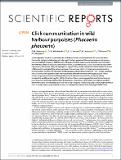Files in this item
Click communication in wild harbour porpoises (Phocoena phocoena)
Item metadata
| dc.contributor.author | Sørensen, P. M. | |
| dc.contributor.author | Wisniewska, D. M. | |
| dc.contributor.author | Jensen, F. H. | |
| dc.contributor.author | Johnson, M. | |
| dc.contributor.author | Teilmann, J. | |
| dc.contributor.author | Madsen, P. T. | |
| dc.date.accessioned | 2018-07-12T13:30:15Z | |
| dc.date.available | 2018-07-12T13:30:15Z | |
| dc.date.issued | 2018-12-01 | |
| dc.identifier | 254682621 | |
| dc.identifier | 69c2a16e-9314-47ba-9ae0-a2a6249435c4 | |
| dc.identifier | 85049179110 | |
| dc.identifier | 000436233600030 | |
| dc.identifier.citation | Sørensen , P M , Wisniewska , D M , Jensen , F H , Johnson , M , Teilmann , J & Madsen , P T 2018 , ' Click communication in wild harbour porpoises ( Phocoena phocoena ) ' , Scientific Reports , vol. 8 , 9702 . https://doi.org/10.1038/s41598-018-28022-8 | en |
| dc.identifier.issn | 2045-2322 | |
| dc.identifier.uri | https://hdl.handle.net/10023/15314 | |
| dc.description | The data collection was funded by the German Federal Agency for Nature Conservation (BfN) under contract “Cluster 7 - Effects of underwater noise on marine vertebrates” and “UWE - Under Water Experiments”. FHJ was supported by the Office of Naval Research (N00014-1410410), the Carlsberg Foundation (CF15-0915) and an AIAS-COFUND fellowship from Aarhus Institute of Advanced Studies. MJ was supported by the Marine Alliance for Science and Technology Scotland (MASTS) and by a Marie Curie-Sklodowska award. | en |
| dc.description.abstract | Social delphinids employ a vocal repertoire of clicks for echolocation and whistles for communication. Conversely, the less social and acoustically cryptic harbour porpoises (Phocoena phocoena) only produce narrow-band high-frequency (NBHF) clicks with properties that appear poorly suited for communication. Nevertheless, these small odontocetes likely mediate social interactions, such as mate choice and mother-calf contact, with sound. Here, we deployed six tags (DTAG3) on wild porpoises in Danish waters for a total of 96 hours to investigate if the patterns and use of stereotyped NBHF click trains are consistent with a communication function. We show that wild porpoises produce frequent (up to 27 min-1), high-repetition rate click series with repetition rates and output levels different from those of foraging buzzes. These sounds are produced in bouts and frequently co-occur with emission of similar sounds by nearby conspecifics, audible on the tags for >10% of the time. These results suggest that social interactions are more important to this species than their limited social encounters at the surface may indicate and that these interactions are mediated by at least two broad categories of calls composed of short, high-repetition rate click trains that may encode information via the repetition rate of their stereotyped NBHF clicks. | |
| dc.format.extent | 11 | |
| dc.format.extent | 3808614 | |
| dc.language.iso | eng | |
| dc.relation.ispartof | Scientific Reports | en |
| dc.subject | QH301 Biology | en |
| dc.subject | NDAS | en |
| dc.subject.lcc | QH301 | en |
| dc.title | Click communication in wild harbour porpoises (Phocoena phocoena) | en |
| dc.type | Journal article | en |
| dc.contributor.sponsor | European Commission | en |
| dc.contributor.institution | University of St Andrews. Bioacoustics group | en |
| dc.contributor.institution | University of St Andrews. Sound Tags Group | en |
| dc.contributor.institution | University of St Andrews. Marine Alliance for Science & Technology Scotland | en |
| dc.contributor.institution | University of St Andrews. School of Biology | en |
| dc.contributor.institution | University of St Andrews. Scottish Oceans Institute | en |
| dc.identifier.doi | https://doi.org/10.1038/s41598-018-28022-8 | |
| dc.description.status | Peer reviewed | en |
| dc.identifier.grantnumber | PCIG10-GA-2011-304132 | en |
This item appears in the following Collection(s)
Items in the St Andrews Research Repository are protected by copyright, with all rights reserved, unless otherwise indicated.

